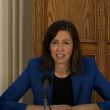Oklahoma City uses muni Wi-Fi to monitor weather
The successful implementation of Wi-Fi mesh technology throughout Oklahoma City’s metropolitan area recently was highlighted in Tech Talk. Now, at least one application has created a new field of research into weather patterns in urban areas. Such data is proving to be useful for both the city’s daily operations and public safety.
Oklahoma City’s mesh network spans about 95% of the city. About two years ago, the Oklahoma Climatological Survey (OCS), in partnership with the city, the University of Oklahoma and Oklahoma State University, found a way to piggyback onto the Wi-Fi network to measure atmospheric conditions every minute throughout the city on a year-round basis.
This initiative, called the Oklahoma City Micronet, was created out of a six-week field experiment that began in the summer of 2003. After the terrorist attacks on the World Trade Center and the Pentagon on Sept. 11, 2001, the Department of Homeland Security, the Department of Energy and the Department of Defense wanted to understand how chemical weapons and viruses released in the air might move throughout a city.
The project is now 18 months old and leverages a mesonet — a network of 36 monitoring sites mounted on traffic signals that automatically capture weather conditions, said Jeff Basara, director of research with OCS and an adjunct associate professor with the University of Oklahoma’s School of Meteorology.
Oklahoma City offered its Wi-Fi network to the project free of charge in 2007 in exchange for the data the initiative generates, which the city uses to assess weather conditions in order to dispatch trucks in a storm or check out flood-prone areas. The mesonet measures a host of weather conditions, including rainfall, temperature, air pressure, wind direction, wind speed and humidity levels.
The mesonet is not wireless in nature. It leverages the city’s Wi-Fi access points to power its weather stations, while an Ethernet cable transmits the data back to researchers. Some 500,000-plus observations are received from the Oklahoma City Micronet every day and automated software evaluates the data received from the remote stations.
Basara said the OCS is gathering some information that has come as a surprise to researchers and could assist first responders in times of severe weather. For instance, researchers have found that the temperature in the city is usually 10 degrees higher than in the surrounding rural areas that are miles away. Basara calls this phenomenon the urban heat island effect. Concrete, steel and less greenery, combined with the fact that buildings and vehicles release heat, contribute to the elevated temperatures.
“There is not a great grasp on how severe weather is impacted by higher temperatures in cities. Most of the observing infrastructure has been in rural areas,” Basara said.
Thunderstorms and tornadoes may behave differently within a city because of the temperature change. During heat waves, which are common in Oklahoma, this elevated temperature effect can be extremely dangerous, resulting in death. Basara said the information OCS gathers can help predict which people may be more at risk during a heat wave.
“We want to really begin to understand down to the neighborhood scale what people might be at risk,” he said.

















